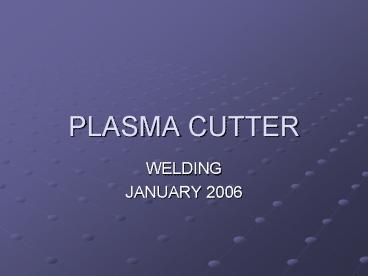PLASMA CUTTER - PowerPoint PPT Presentation
1 / 11
Title:
PLASMA CUTTER
Description:
The electricity is used for cutting and the air blows away the sparks and melted ... electric arc through a small orifice, the torch delivers a high concentration ... – PowerPoint PPT presentation
Number of Views:2528
Avg rating:3.0/5.0
Title: PLASMA CUTTER
1
PLASMA CUTTER
- WELDING
- JANUARY 2006
2
(No Transcript)
3
(No Transcript)
4
PLASMA CUTTER
- Industry standards to replace Oxy-Acetylene
torches. - Also a cleaner cut.
- Uses electricity and compress air. The
electricity is used for cutting and the air blows
away the sparks and melted metal. - Use Safety glasses to protect your eyes from the
rays coming off the machine - Make sure air lines are water free. Plasma
cutter hates water. - The Plasma cutter should cut up to 1/2" thick
metal.
5
A. Plasma Gas Flow.
- Plasma is a gas which has been heated to an
extremely high temperature and ionized so that it
becomes electrically conductive. - The plasma arc cutting and gouging processes use
this plasma to transfer an electrical arc to the
workplace. The metal to be cut or removed is
melted by the heat of the arc and then blown
away. - While the goal of plasma arc cutting is
separation of the materials, plasma arc gouging
is used to remove metals to a controlled depth
and width.
6
Plasma Basics
- Plasma looks and behaves like a high-temperature
gas, but with an important difference it
conducts electricity and cuts any electrically
conductive metal. - The plasma arc results from electrically heating
a gas, typically air, to a very high temperature.
This ionizes its atoms and enables them to
conduct electricity. - A plasma arc torch uses a "swirl ring" that
spins the gas around an electrode. The gas is
heated in the chamber between the electrode and
torch tip, ionizing the gas and creating plasma.
This causes the plasma gas to greatly expand in
volume and pressure. The small, narrow opening of
the torch tip constricts the plasma and
accelerates it toward the work piece at very high
speeds (20,000 ft./s) and temperatures (up to
30,000 F). - The high-intensity plasma jet melts a very
localized area. - The force of the jet (or arc) pushes through the
work piece and removes the molten metal. - This jet easily cuts through metals with poor
heat conductivity (stainless steel) or excellent
conductivity (aluminum). - The flame created by an oxy-fuel torch lacks
plasma's concentration and cuts stainless steel
or aluminum so poorly (excess warping or dross)
that professionals don't bother to use it they
consider plasma arc cutting the standard process
for these metals.
7
- Cool gas enters Zone B, where a pilot arc between
the electrode and the torch tip heats and ionizes
the gas. - The main cutting arc then transfers to the work
piece through the column of plasma gas in Zone C - By forcing the plasma gas and electric arc
through a small orifice, the torch delivers a
high concentration of heat to a small area. The
stiff, constrict plasma arc is shown in Zone C.
Direct current (DC) straight polarity is used for
plasma cutting, as shown in the illustration. - Zone A channels a secondary gas that cools the
torch. This gas also assists the high velocity
plasma gas in blowing the molten metal out of the
cut allowing for a fast, slag free cut.
B
B
A
C
C
8
(No Transcript)
9
Operation of Plasma Cutter
- Plug in plasma cutter to 220 volt circuit. (same
as the welder) - Connect air line--check gages to make sure you
have about 60 of line pressure - Adjust heat knob to the correct setting for the
metal. The higher the setting the more heat. - Connect ground clamp to work.
- Turn on--Red light should appear when ready.
- With eye protection "hit" the black top knob and
red bottom knob on handle. - Make sure your are at the right distance with
handle - Cut.
10
Problems Using the Plasma Cutter
- Make sure ground clamp is connected to metal
- You have 60 of air pressure
- If plasma cutter does not work--check and change
cutting tip and nozzle. - Check to make sure there is no water in the line
- Check for voltage drop.
11
(No Transcript)































